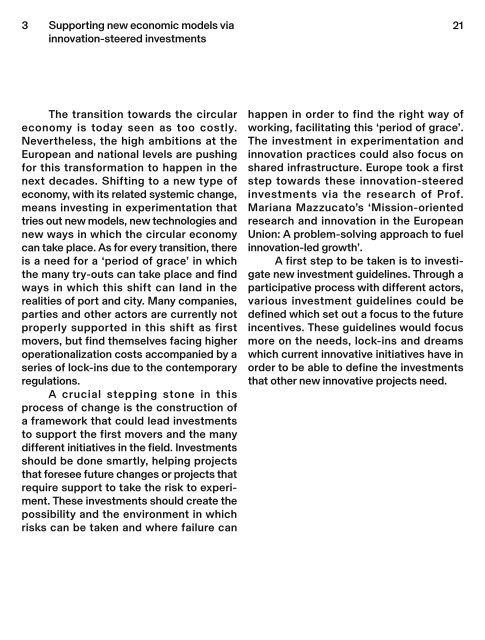Circular (City) Ports_Shaping Future Changes
- No tags were found...
You also want an ePaper? Increase the reach of your titles
YUMPU automatically turns print PDFs into web optimized ePapers that Google loves.
3 Supporting new economic models via<br />
innovation-steered investments<br />
21<br />
The transition towards the circular<br />
economy is today seen as too costly.<br />
Nevertheless, the high ambitions at the<br />
European and national levels are pushing<br />
for this transformation to happen in the<br />
next decades. Shifting to a new type of<br />
economy, with its related systemic change,<br />
means investing in experimentation that<br />
tries out new models, new technologies and<br />
new ways in which the circular economy<br />
can take place. As for every transition, there<br />
is a need for a ‘period of grace’ in which<br />
the many try-outs can take place and find<br />
ways in which this shift can land in the<br />
realities of port and city. Many companies,<br />
parties and other actors are currently not<br />
properly supported in this shift as first<br />
movers, but find themselves facing higher<br />
operationalization costs accompanied by a<br />
series of lock-ins due to the contemporary<br />
regulations.<br />
A crucial stepping stone in this<br />
process of change is the construction of<br />
a framework that could lead investments<br />
to support the first movers and the many<br />
different initiatives in the field. Investments<br />
should be done smartly, helping projects<br />
that foresee future changes or projects that<br />
require support to take the risk to experiment.<br />
These investments should create the<br />
possibility and the environment in which<br />
risks can be taken and where failure can<br />
happen in order to find the right way of<br />
working, facilitating this ‘period of grace’.<br />
The investment in experimentation and<br />
innovation practices could also focus on<br />
shared infrastructure. Europe took a first<br />
step towards these innovation-steered<br />
investments via the research of Prof.<br />
Mariana Mazzucato’s ‘Mission-oriented<br />
research and innovation in the European<br />
Union: A problem-solving approach to fuel<br />
innovation-led growth’.<br />
A first step to be taken is to investigate<br />
new investment guidelines. Through a<br />
participative process with different actors,<br />
various investment guidelines could be<br />
defined which set out a focus to the future<br />
incentives. These guidelines would focus<br />
more on the needs, lock-ins and dreams<br />
which current innovative initiatives have in<br />
order to be able to define the investments<br />
that other new innovative projects need.


















